Alex Gartelmann couples formal visual principles commonly found in architecture and sculpture with alternative visions to create artworks that establish a weirdly subversive and ambiguous cosmology. Last month The COMP Magazine visited Gartlemann’s westside industrial corridor studio to discuss his time in Chicago, the influence of skateboarding on his studio practice, his collaboration with Jonas Sebura, and relocating to Philadelphia in 2016.
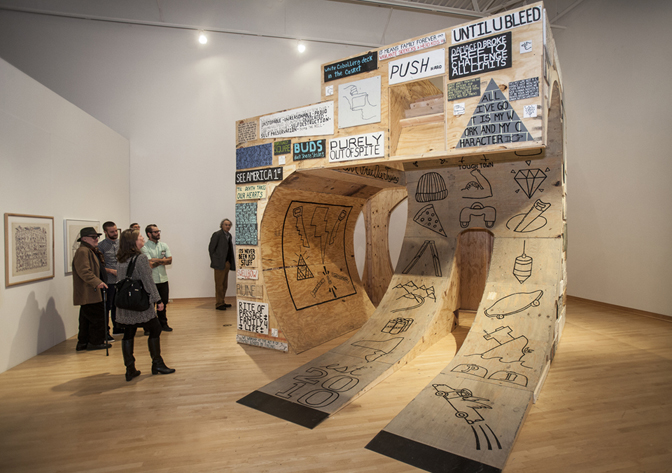
Sebura & Gartelmann, Church, 2014
wood, paint, steel, and shoes
144x144x144 inches
You are from out east (New Jersey) and soon will be heading to Philadelphia to live and work. Are there any specific Chicago experiences that have influenced your current art practice?
I’ve always had an interest in architecture. Being in Chicago has really galvanized that interest as an essential part of my practice. Being able to experience the genesis and legacy of American architectural style has been deeply formative. This is not only in formal reference, but in looking at the deeply problematic legacies of urban and suburban planning. Chicago is prime for that type of research, both in critical texts as well as more importantly just existing here and experiencing the fallout in person.
Additionally, this part of the country offers unparalleled access to a critical mass of vernacular art and architecture. Chicago’s proximity to Wisconsin, and places like the Dickeyville Grotto, the Mary Nohl site, Fred Smith’s Wisconsin Concrete Sculpture Park, and Ernest Hupeden’s Painted Forest, have been crucial for me to see. That type of work is so important as a reference for granting my self permission in the studio to take risks and just work because I have to.
Having the opportunity work and become close with Jim Zanzi and Lisa Stone has changed my life as well.
Most significantly I met Jonas Sebura, my collaborator, while I was here.
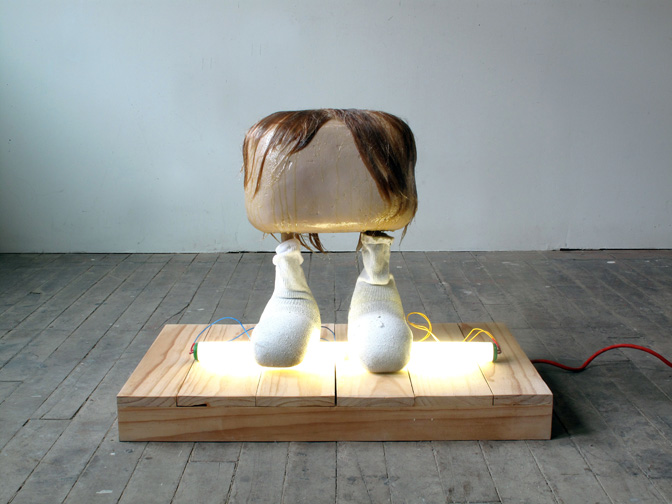
Sebura & Gartelmann, Portrait of the Artists at Age 14, 2014
foam, foamcoat, paint, wig, epoxy, resin, concrete, lighting, wood, and socks
36x24x20 inches
Do you see any connections between your fondness for skateboarding and your current aesthetic efforts?
I talk about this a lot now that Jonas and I have made some work centering around our experience of growing up skateboarding and continuing to do so. Both of us have always been quite hesitant to toe into those waters. But there is such a deep parallel in art making and skateboarding. Both offer total agency, both offer dealing with and working through an endless series of failures, risk taking for progression, and self accountability. Skateboarding is often paired against team sports as some type of antithesis or foil, and I feel like having a studio practice functions in the same way to larger cultural expectations about being an adult or professional. It sounds grossly cliché, but I think there is some profound truth in that notion related to the cultural ideological positioning we are seated in.
Besides the ties of tenets, issues of form, architecture, and alternative vision are ways that the two overlap for me. One of the best things about skateboarding is that you are constantly working to turn the inanimate and mundane world into something important and actively purposeful. Skateboarders obsessively look at everything around them thinking about how they can re-purpose it for their needs. I try to keep that level of rigorous intellectual openness in how I approach material and process in my studio. It’s a really fruitful approach for me to keep. It’s tied to a keen level of looking and awareness, especially towards typically ‘invisible’ infrastructures. I recommend looking at recent interviews with Vito Acconci. He loves skateboarding for these exact reasons, and talks at length about it.
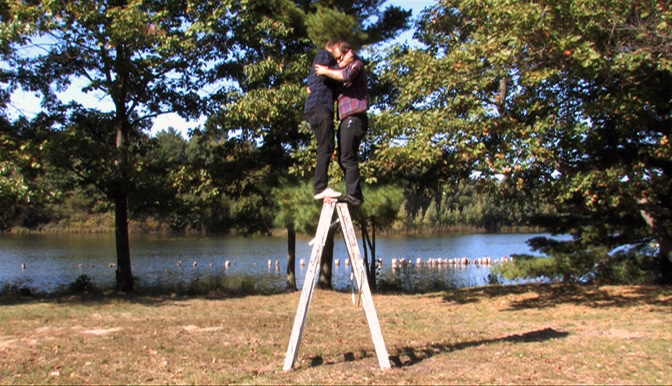
Sebura & Gartelmann, This Is Not a Step, 2011
Digital Video, 2:02
I’m really interested in the work, Shit Guilty. This sculpture is a soiled t-shirt suspended from a hanger with the words Shit Guilty written backwards upon it. There’s a sense of sordidness that reminds me of a nefarious night out. What is the intent of this work?
That piece developed from thinking about growing up and wanting so badly to be a part of something that was outside of the world I grew up in. There is a history in hardcore where people would write the names of the bands on white tees. I was thinking a lot about that move as a way to self identify, which has these two paths for me, one in that where I grew up I never would have been able to find band t shirts from that world, and secondly this gesture towards signifying class. You could mail order or travel into the city for a show and get merchandise if you could afford to. I didn’t have money so that was a rare option for me. It’s so much more compelling to make that choice for yourself instead of just buying an item that describes how you align yourself. You could write Bad Brains on it or you could write the name of your friend’s high school band that only ever played for themselves in their parent’s basement. There is something radically equalizing about that. I’m attracted to the idea of a blank space with which anything can be placed.
The state of the shirt comes from thinking about that being the only shirt I would ever wear. It’s state of being was a direct vision of never taking it off, of it being permanently connected to me and taking on all the mess of my life.
The language came from a piece of writing I had been working on about the time period when my grandfather passed away, and how I felt all this guilt about not being more pro active in getting to know him. There is something about the mix up of potentials in what is the verb or noun or adjective in that rather dumb placing of two words that is really compelling to me, and again speaks to the liminal mess of life that I’m interested in. It could be some profound feeling of guilt (which it is) or it could be the literal act of taking a shit while feeling guilty (which it also is), or any other number of things that the language could be assigned to. The oddness of it really pulled me in.
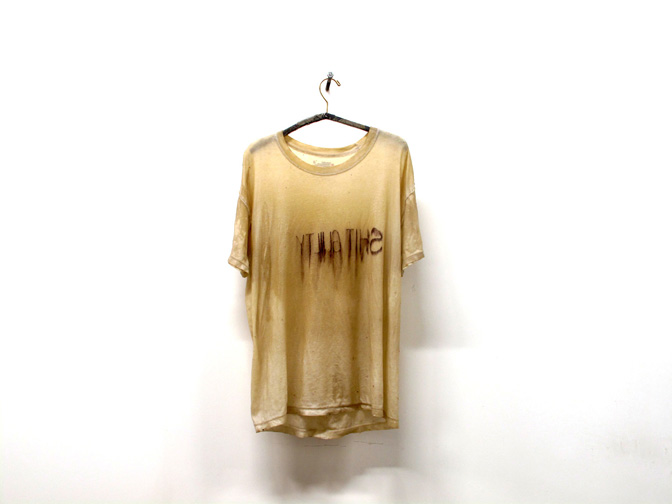
Alex Gartelmann, Shit Guilty, 2014
t-Shirt, epoxy, resin, wood, tape, brass,
21x36x6 inches
You’ve worked with Jonas Sebura for some time on a variety of projects. Can you share with us a little background and history on your collaborative work?
Jonas was the first person I met in grad school. Our background story honestly has all the trappings of a cheesy movie about best friends, which to me is kind of beautiful and hilarious. We worked as TA’s in the foundry, where we both had long and rather fraught relationships with the material and process. We bonded over that, and from there started to realize we had all these common interests. We started to recognize we were making uncannily similar work with out knowing each other while in this grad seminar together. Jonas had this opportunity to do a show at our friend Nate’s gallery in Missoula Montana just after the new year. He asked if I wanted to do it with him. We co-bought a beater 1999 maroon Ford F-150 that had sketchy breaks, no working heat, and ended up needing a new alternator (which we found out when we got to Billings Montana) and drove the 1800 miles from Chicago to Missoula together, more or less as strangers. It was the first Christmas I hadn’t spent with my family in New Jersey. It became a christening into a new family I guess you could say. From that point on we have been working together for the past 6 years. It’s pretty much the best.
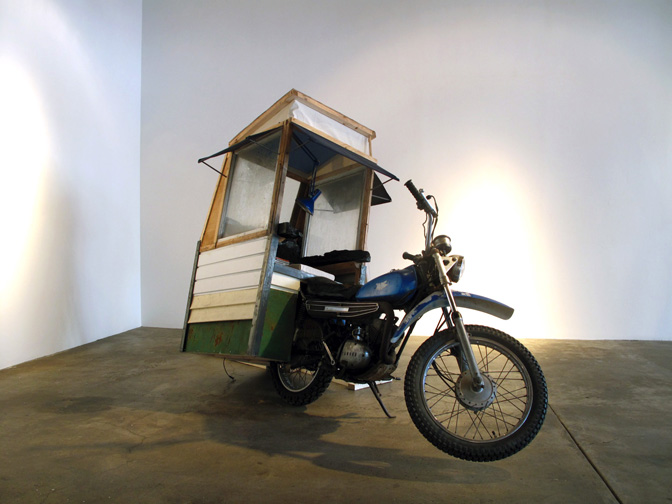
Sebura & Gartelmann, Enduro, 2012
motorcycle, wood, steel, plastic, fabric, books, lighting,
84x73x40 inches
What do you value in the art-making process?
I value never having answers to what I’m doing. I value craftsmanship, but I also value being able to subvert the notion of any expectation. Once you acquire virtuosity, you learn not to trust it. I value intuition in the studio, and letting intuition and the lack of clear answers intersect as a method for problem solving, both physical and conceptual. I value mistakes and fuck ups. Architecture, The Vernacular, never being cool, working hard because I don’t have natural talent. And being sincere.
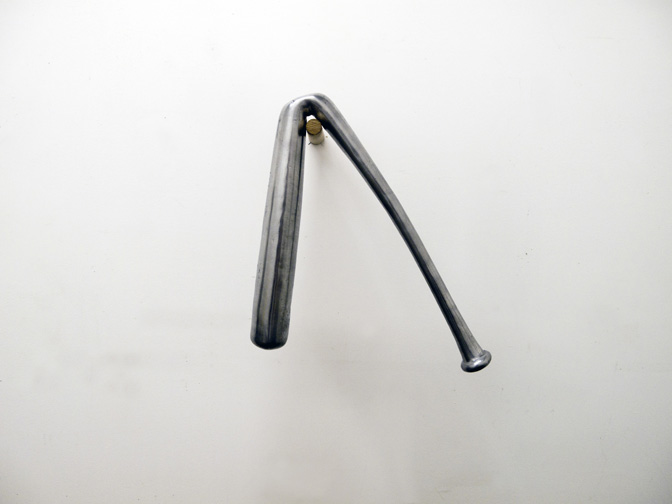
Alex Gartelmann, Over and Over and Over, 2012
cast aluminum, wood, plasti dip,
14x9x17 inches
You are also an educator. Do you have any specific philosophies or practices that you attempt to instill in your students?
There are a few things that I really stress to my students. I don’t know if there is a hierarchy to them, but I hope that I can give them insight into strategies for being in the studio. I stress the importance of really figuring out what is at stake in making art for them. I really push them towards figuring out what they really truly care about as an individual. I like to give them clunky examples, ‘you might care the most about cats or grass’ to show that they don’t need to feel compelled to mask what they might really care about because they feel it’s not ‘smart’ enough or that it’s not cool enough. If I could kill the idea of cool I would so quickly. I actively discourage and call people out for that attitude in the class room. It removes you from your ability to be rigorous in dissecting what you really value. You always look outward instead of first inward to then look outward. This all comes from things that I stumbled through. I also stress that talent or skill doesn’t mean shit. Typically, if you rest on those laurels you make incredibly boring work. I go back to that issue of virtuosity and not trusting it. It’s important to totally fuck up and have giant failed messes. Those are the most generative spaces to be in, in the studio. I want the students to know it’s not only okay but essential to have that happen. But it has to be on the terms that they took a huge risk and challenged themselves. Failure from laziness and complacency are cardinal studio sins.
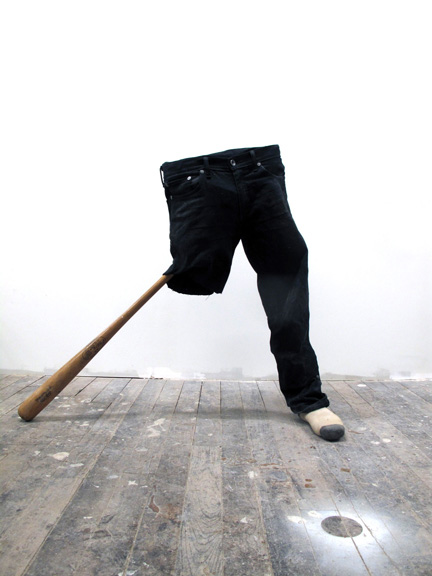
Alex Gartelmann, Prop, 2014
Hank Aaron Signature Model Hillerich & Bradsby Ash Baseball Bat, pants, epoxy, resin, foam, and sock
34x38x11 inches
Do you have any exhibitions or projects you plan to produce once settled in Philly?
My partner, Paige Fetchen, and I have been drawing up plans to open an exhibition space. We are really excited at the opportunity to intersect artists we love from Chicago with artists we love from Philadelphia (and other places of course). Jonas and I are going to be doing the Kohler Arts and Industry Residency this upcoming summer as well. We are also collaborating with our friend Patrick Buckley in Brooklyn on a little self directed project around a trip we are taking to Niagara Falls. We have some other stuff in the pipeline, but we have to keep that a bit lower key right now. Ultimately, just planning to keep working.
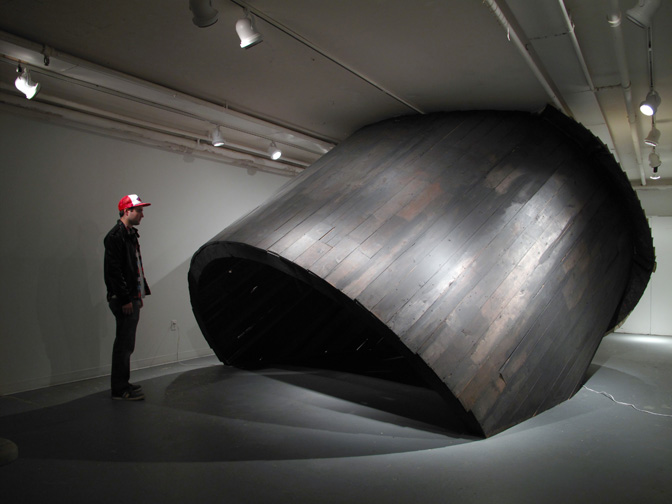
Sebura & Gartelmann, The Heart, Still, 2012
wood, vinyl, aluminum, paint,
108x108x108 inches
For additional information on the work of Alex Gartelmann, please visit:
Alex Gartelmann – http://alexgartelmann.com/
Sebura & Gartelmann – https://seburaandgartelmann.wordpress.com/
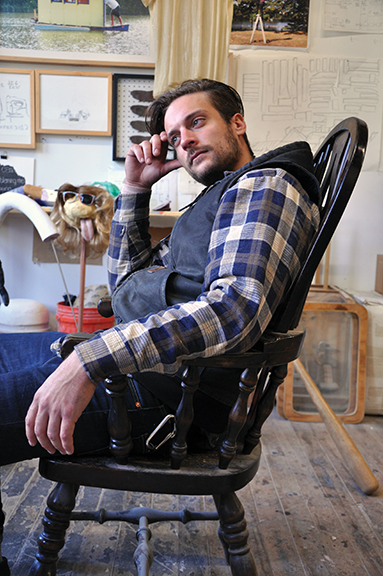
Alex Gartlemann, sculptor, Chicago, IL, 2015
Artist interview and portrait by Chester Alamo-Costello


